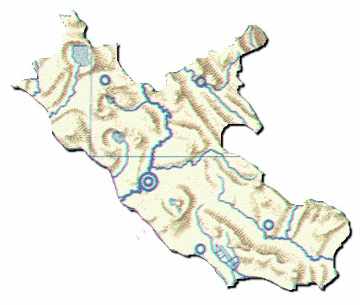
|
LAZIO
|
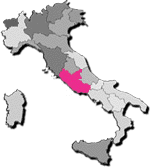
Back to Italy |
Provinces
- This region has 5 province: Frosinone, Latina, Rieti, Roma, Viterbo
Chief town
- Roma
Surface
- kmq 17203
National Parks
- National Park of Abruzzo (1923)
national Park of Circeo (1934)

Russian Version |
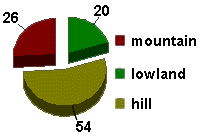 |
|
Origin of the name:
Even before the birth of Rome, this territory was
called Lazio, from the Latin Latium, lived by the people of Latin and
situated in the zone of the low Tevere. After the period of the republican
epoch the confinements were widened and with the arrangement of August in the
Roman epoch, the Region included both Lazio that Campania.
| Reliefs - Passes - Coasts -
Islands: |
The territory is
predominantly mountainous and hilly, while lowlands are found in proximity to
the coastal shores. In the oriental part we find a modest section of Appennino,
that inserts the zones of border with Umbria, Marche and Abruzzi.
In this territory rise the lower part and isolated Sabini Mountains and
the Reatinis Mountains in which rises the tallest mountain: Terminillo with his
2213 ms. Coasting along the border with the Abruzzi, finds the Simbruinis
Mountains and the Ernicis Mountains characterized by their drought and scarce
vegetation. Between the Ernicis and the mountains of the Preappennino, the
valley of the Ciociaria is found, very fertile zone where they pass the rivers
Liri and Sack. The northern zone of the Region, between the Tevere and the
coast, it has occupied from a series of mountains that are: Tips Mountains,
Volsinis Mountains and Sabatinis Mountains. To south of Tevere there is
the group of Colli Albani.
|
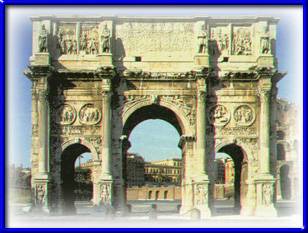
Arc of Costantino in Rome
|
All these mountainous groups are very old, of volcanic
origin and almost never overcome the 1000 ms. In the most active craters there
are fully grown of the lakes. These zones are very fertile and well cultivated,
particularly to vineyards. In the southern part there are Lepinis Mountains,
Ausonis Mountains and Auruncis Mountains, whose crests have corroded, arid and
ploughed by strong landslides, because treat him of ancient mountains. Along
the whole coast the level part of the territory of Lazio is found. To north, in
the amplest lowland, we find Maremma laziale that then continuous with
Tuscany; in the central zone there is the Roman Country where Tevere
passes; finally to south the sour Pontino, called still also Swamps Pontine for
some swampy zones after the 1930 and 1940 reclamation. A long time ago these
level zones were of the swamps that then in the time they were reclaim and that
today they are cultivated and divided in farms. The coast is very regular, low
and sandy. There are some prominences as Head Linaro, Delta of the Tevere, Head
Circeo and Promontory of Anzio and Gaeta where the homonym is found the port.
In front of the port of Gaeta, we find the archipelago Pontino constituted from
six islets all of volcanic origin, even if of the volcanos few they remember
sight the incisive action of the waves of the sea. The principal one is that of
Ponza.
Landscape:
Looking at the whole territory, seems that this
Region is composed by different landscapes: a zone northerner with irte and
desolate mountains that remember those marchigianes, others rich in vegetation
with green woods and expanses of ulivi that recall to the mind Umbria. From the
northern zone a level zone is mixed with the Tuscan Maremma and in that
southern where we find the end of the level zones. Quìs are lifted on the coast
of the rocks that they precede those of Campania.
Agriculture - Stock-farm -
Fishing:
Cereals are cultivated, above all wheat and oat
in the level zones of Viterbo, Rome and Latin. The crops of vegetables and
fruit trees are very developed. In the southern zone are cultivated the citrus
fruit. In the hilly territories life trees and ulivi are cultivated. For the
production of table wine and oil Lazio occupies one of the first places in
Italy. The most prestigious zones for the production of wine are the Colli
Abani, Formia, Montefiascone and Terracina. Sugar beets and tobacco are also
produced in notable quantity. A lot of zones turned to pasture, have been
reclaim for being destined to the agriculture. Although the breedings decrease
continually, the number of ovini always stays elevated and it puts the region
to the second place, only after Sardinia. Detail is the breeding of the
buffalos, that the refined person allows production of mozzarella. Very
important it is the fishing practiced in the Tyrrhenian Sea and Mediterranean.
The motopeschereccis make port in the harbors in Civitavecchia, Gaeta and
Fiumicino.
| Industry - Tourism: |
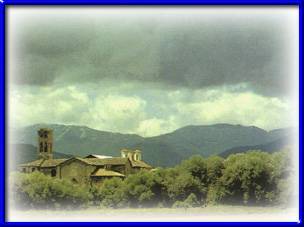
Church of S. Michele in the Basin Reatina
|
Lazio is not a Region very
industrialized. Principal activities are those of the mechanics, to feed and of
the tobacco developed in the presses of Rome. New industrial roads are being
opened, between which the pharmaceutical industry, chemistry, graphics, cinema
and of the clothes. Main point is the nuclear center in the press of Frascati.
The tourism is one of the principal economic resources of Lazio; the alone city
of Rome calls numerous tourists, Italians and foreigners back. Besides the
famous artistic and cultural affairs, the City of Vatican also recalls
many religious. The bathing stations have also aspired and the archaeological
places as Cerveteri and Tarquinia.
|
Position and Frontier:
The territory that understands Lazio is extended from
the Appennineses and goes down to the coast of the Tyrrhenian Sea. This zone is
included by the rivers Fiora to north and Garigliano to south. The Region
confines to north with Tuscany, Umbria and a brief line of Brands; to east with
Abruzzi, Molise and Campania, to south and to west, with Tyrrhenian Sea.
Rivers - lakes:
In the Tyrrhenian Sea flow Tevere and others small
rivers, between which Marta that goes out of the Lake of Bolsena and Fiora. In
the southern zone of the Region are found Sacco and Liri. Between the lakes,
numerous in Lazio, we remember that of Bolsena in Volsinis Mountains; the Lake
of Vico in the Cimini Mountains; the Lake of Bracciano, in the Sabatinis
Mountains; the Lake of Albano and Nemi in the Necks Albani.
Climate:
The coastal part has profited from the sea that
mitigates the winters and refreshes the summers. In the departs inside of
the Region the winter is rigid and the summer is warm. In the coastal shore and
in the lowlands the rains are scarce, while on the mountains they are very
abundant especially in the winter and spring periods.
Population:
The density of population in the Lazio is the third of
Italy, preceded only from Lombardy and from Campania. The inhabitants are
distributed in very irregular way. Over half the population occupies the alone
city of Rome and besides seen the influx of immigrates, the population has
almost reached the three thousand. Contrarily the mountainous and hilly zones
are a little populated. Other very big urban centers there are not in the
territory of Lazio. Latin it grazes the 100 thousand inhabitants and the other
chief towns are around 50 thousand, while the other centers are being under
everybody 50 thousand. Generally in Lazio it is used to live all in assembled
places. The only that live in isolated way are the farmers that live in the
reclaimed zones.
Communication:
From Rome all the roads and the principal railway lines
depart. The run of the primary roads is traced from the ancient Roman roads:
Flaminia arrives to Rimini, Cassia reaches Florence, Aurelia climbs up to
Florence, Appia with Brindisi, Salaria connects Rome to Ascoli Piceno and
Triburtina arrives up to Pescara. In Rome there are two airports: that of
Ciampino and that of Fiumicino.
Web Site designed by
MediaSoft - © Copyright 1998-1999 - All rights reserved




